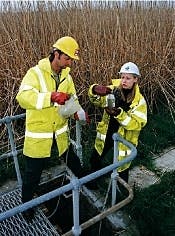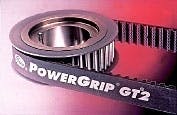New severe service choke valve
A new severe service choke valve for oil and gas production uses a combination of DRAG velocity control technology and advanced materials to promise long trim life and precise process control.
Its design suits it for use in separator level control. Normally this valve application, the company says, suffers from sand erosion and cavitation, but the choke valve trim is made from solid tungsten carbide and is multistaged so that cavitation is prevented.
The fluid velocities within the trim of the choke are typically one-third to one-fourth that of conventional single stage chokes, the company notes. Velocity control protects the trim from erosion and helps increase trim life. Another feature of velocity control is that the noise and vibration levels are reduced. The suppression of vibration eliminates common mechanical failures caused by fatigue and impact loads on the tungsten carbide parts.
Solid tungsten carbide is used for the plug rather than leaving it just carbide tipped. And the disk stack that provides for multistage letdown is also made from solid tungsten carbide. The seat ring is provided with a tungsten carbide venturi, allowing for a controlled, erosion-resistant expansion into the choke outlet and downstream piping.
Source: CCI, 22591 Avenida Empresa, Rancho Santa Margarita, CA 92688.
Firm's fiberglass pipe approved for offshore use
The American Bureau of Shipping (ABS) has approved this company's offshore product line for use aboard ships, offshore rigs, and similar operations.
This specially designed product line is based on Red Thread II and Green Thread pipe and fittings and has passed the IMO A753 (18) L3 fire endurance test.
The product line, known as Red Thread II OS and Green Thread OS piping, survived an 1,800° F. fire endurance test for 30 min without leaking, the company says. Then, the same piece of pipe had to withstand 232 psi hydrostatic pressure for 15 min, the firm notes.
The OS product line is ABS approved for open decks, cofferdams, void spaces, pipe tunnels, ducts, cargo tanks, fuel oil tanks, and ballast water tanks.
ABS approved OS pipe is rated at 225 psig and is available in 2 in. through 16 in. sizes. OS pipe is offered in standard wall thickness, as well as a 3 mm wall thickness to meet United Kingdom Offshore Oil Association standards. The OS product line includes lined and unlined pipe and fittings. Approved fittings include a complete line of 1.5 D sweep radius filament wound fittings and filament wound flanges.
Source: Smith Fiberglass Products Co., 2700 W. 65th St., Little Rock, AR 72209.
Reed beds help treat oil field effluent
Soil-based reed beds are designed to treat many effluents, including those from oil exploration and processing operations.
The beds can clean up any industrial and commercial process that produces contaminated water, the company says.
The wetland plant used is the deciduous common reed-Phragmites australis. The green aerial parts of the plant grow back from an extensive network of rhizomes each spring. Because the naturally occurring bacteria associated with its root structures are responsible for breaking down waste products, such reed-bed treatment can continue throughout the winter months, the firm notes.
Source: Oceans Environmental Engineering Ltd., 4 Cumberland House, Greenside Lane, Lidget Green, Bradford, Yorkshire, UK BD8 9TF.
New belt drive system
The new PowerGrip GT2 belt drive system is designed for high-speed synchronous drives above 500 rpm.
High-strength rubber compounding built into the belt teeth and a tough nylon fabric on the tooth surfaces help provide durability. A neoprene backing, bonded to the high-strength tensile member, allows the belt to resist elongation and improve belt stability compared with other belts using aramid tensile members.
These new design features allow GT2 belts to transmit up to 200% more horsepower than first generation curvilinear synchronous belts, the company says. The belt can be used on narrower, more compact, and less costly belt drive systems, the firm adds.
The belt operates continuously at peak efficiency with minimal need for retensioning, which reduces both energy and maintenance costs, the company notes.
Source: Gates Rubber Co., Box 5887, Denver, CO 80217.





